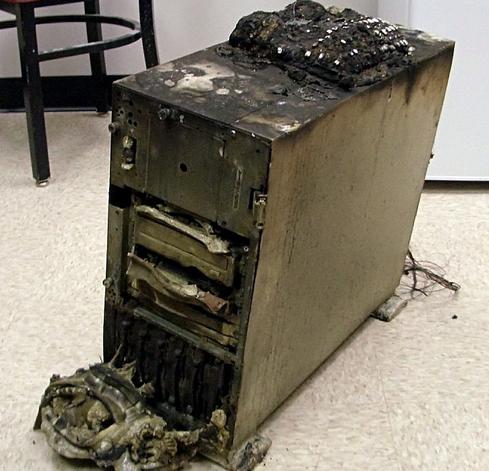IT's Famous Last Words: If It Ain't Broke, Don't Fix ItIT's Famous Last Words: If It Ain't Broke, Don't Fix It
Continuing with an inflexible IT strategy until something breaks will break your business. Here are few ways to not get left behind.

I recently visited a client who took me on a tour of the company's rather impressive datacenter. As I was about to leave the pristine environment I noticed a tangled mass of cables and an isolated server that looked oddly out of place. Being naturally inquisitive, I asked what it supported. With a wry smile my host responded with, "Oh, that's not broken so we don't fix it." This line got me thinking a lot about business and IT strategy.
In IT, we've become accustomed to managing services the same way. We keep our heads down and our systems running, prevent outages, and implement new applications. In business, our competitors play the same game, so we pay close attention to making sure our services perform at optimal levels.
[Buying business software can be tricky business. Read: 6 Enduring Truths About Selecting Enterprise Software.]
This is, and always will be, important. But with the digital revolution, just running an IT shop better than anyone else doesn't guarantee anything. Rather, success will depend on how quickly you market your offerings, how you structure your IT services, and especially how well you understand the pivotal role IT plays when it comes to remodeling your business.

To draw a parallel from the cut-throat world of retail fashion, clothing and accessory store Zara has become a huge success by developing a disruptive new strategy -- and not because they have better stores than their competitors. They looked at what many in their industry regarded as the "not broken" element -- slow time to market from initial garment design to shop floor (the tangled cables, if you like), and fixed it with a unique approach (unified design and manufacturing). Similarly, Netflix devastated the home video market, not because their employees worked harder than video store employees, but because they challenged traditional thinking -- thinking that wasn't really broken, just out of step with the move to digital content consumption.
There are valuable takeaways here for IT pros.
Running an outdated IT strategy and managing the status quo is a recipe for disaster. The alternative is to work with the business to continuously review existing business models, re-examine cost structures and reduce operational debt to the point where IT is able to deliver the types of new applications and services that customers want.
Of course, none of this is easy if the entire organization is entrenched in the "not broken, don't fix it" mindset. But fortune favors the bold who challenge traditional thinking.
Here are four reminders for the more strategically inclined:
IT needs to watch over the business: No other enterprise function bridges the business like IT. As such, strategists should be constantly surveying the tech startup and venture capital landscape to determine which new business models are disruptive and/or present opportunities. This isn't about looking at what you can technically do better, but about developing the smarts to question whether existing processes and attitudes could be broken and then convince those unwilling to alter the status quo that a change is needed.
Invest in continuous change: A successful business will radically re-model itself when necessary. To better support moves to collaborative consumption, smart businesses will begin to transform products into services. Extreme agility like this requires similar capabilities from IT teams. For example, IT should deliver the platforms needed for a traditional hardware manufacturer to offer new cloud-based print services -- or help an electricity provider reduce production based on predicting patterns of consumption using advanced smart meters.
Ruthlessly prioritize and consolidate: If your business abides by "If it ain't broke, don't fix it," then chances are your company will have many broken things. In my experience, this usually manifests itself as discrete applications operating on dedicated hardware and unsupported software. They're costly to run with up to 70% of the IT budget dedicated to not "fixing" them. Better services like integrated mobile apps to increase workforce productivity won't come cheap, so start ruthlessly culling your entire application portfolio to fund new initiatives. But remember, this shouldn't be restricted to older applications. Without good governance, shiny new objects like mobile can quickly become the maintenance burden of tomorrow -- especially if your company is juggling a bunch of similar app development projects or supporting hundreds of different device types and operating systems.
Stop meeting and start thinking: Innovation can't be institutionalized or conducted in a formal group setting. Too often rigid brainstorm sessions prevent free-thinking and result in conventional outcomes. That's fine if you have well understood problems to solve, but if you’re looking for innovation, you have to think beyond the confines of the enterprise. This can involve building external developer networks with open data and APIs, engaging customers in ideation projects, or it could be as simple as encouraging your introverted thinker types to speak up.
So the next time you hear the cringe-worthy phrase "If it ain't broke, don't fix it," stop and think. Persisting with a rigid IT strategy is as bad as ignoring that tangled mess of cables in the data center. Always remember, it's the "not broken" things in business that provide the best opportunities for innovation.
Peter Waterhouse is a senior technical marketing advisor for CA Technologies' strategic alliance, service providers, cloud, and industry solutions businesses.
Too many companies treat digital and mobile strategies as pet projects. Here are four ideas to shake up your company. Also in the Digital Disruption issue of information: Six enduring truths about selecting enterprise software. (Free registration required.)
About the Author
You May Also Like






